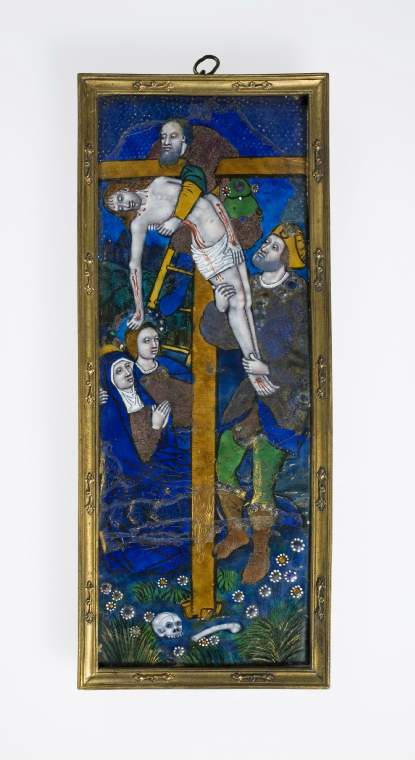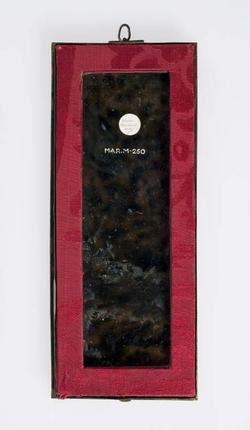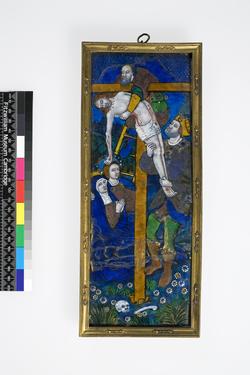Current Location: In storage
Titles
The Deposition
Maker(s)
Workshop:
Penicaud, Nardon
(Probably)
Entities
Categories
Description
Copper decorated with polychrome enamels and jewelling over silver (?) foil, and gilded. Gilt-metal frame
Thick, narrow rectangular copper plaque, enamelled in dark blue, turquoise, green, yellow, flesh pink, red, mulberry, pale brown, black, grey, and white, and gilded.A very thin wash of red produces flesh pink.The jewels and flower centres are foiled in silver (?).The reverse has dark brown counter- enamel.
Joseph of Aramathea stands on a ladder with his right arm over the tau Cross and round the body of Christ which he lowers into the arms of Nicodemus who stands on the right. On the left of the Cross, the Virgin Mary has sunk to her knees, and holds her hands together in prayer. Mary Magdalene (?) kneels beside her with her right arm around her shoulders. A skull and a bone lie at the foot of the Cross. The foreground on each side is scattered with jewelled flowers, and the sky is scattered with stars.
Joseph of Aramathea is balding and bearded. He wears a short mulberry gown over a garment with long yellow sleeves, and blue boots. Christ wears a crown of thorns and a white loin cloth. His white body is tinged with pink and blood trickles from his brow, hands, side, and feet. Nicodemus has a short beard, and a yellow hat with a jewel on its upturned brim. He wears a dark blue and mulberry tunic with jewelling round the neckline, green tights and brown boots with jewelled tops. The Virgin wears a dark blue mantle over a white wimple and mulberry dress. Mary Magdalene has a turquoise jewelled cap over her pale brown hair. She wears a dark blue cloak over a mulberry dress. The skull and bone are white and grey, and the flowers have white dotted petals around yellow and blue foiled centres.
The rectangular gilt-metal frame, has two applied twisted stems with leaf terminals at the top and bottom and five on each the side.
Notes
History note: Uncertain before Charles Brinsley Marley (1831-1912) by whom bequeathed
Legal notes
C.B. Marlay Bequest
Acquisition and important dates
Method of acquisition: Bequeathed
(1912)
by
Marlay, Charles Brinsley
Dating
16th Century, Early
Circa
1520
CE
-
1525
CE
Note
The role of Joseph of Arimathea in the removal of Christ’s body from the Cross and its subsequent burial is described in all the Gospels, but it is only in St John (20.38-40) that Nicodemus is mentioned as his helper. The skull and bone at the foot of the Cross are a reference to name of the site of the Crucifixion, Golgotha, the place of the skull, and to the tradition that the Cross was erected over the grave of Adam.
Limoges plaques of the Deposition were often paired with Christ carrying the Cross as wings of triptychs with the Crucifixion in the centre. Plaques with closely comparable iconography form the right wing of triptychs in the Walters Art Gallery, Baltimore, the Musée du Louvre, Paris, and the Frick Collection, New York. All three triptychs have been attributed to the Penicaud workshop, usually to Nardon, or to a collaboration between Nardon and Jean I Penicaud, but Baratte (2000) preferred to attribute the Louvre’s example to Jean I Penicaud and to date it as late as 1530, rather than in the early 1520s. The Louvre’s plaque differs from the other two in having four bones instead of one, and in having the skull on the right of the base of the Cross instead of on the left. The central panel of the Walters' and Louvre’s triptychs was derived from a woodcut illustration to a book of hours printed in Paris in 1505, and re-used in Antwerp in 1525, which explains the discepancy beween the style of the costume and the suggested date range. This Deposition also occurs in reverse on the left wing of a triptych attributed to Nardon Pénicaud in the Museum des Arts décoratifs, in the Hôtel Lallemant at Bourges.
School or Style
Renaissance
People, subjects and objects depicted
Components of the work
Decoration
composed of
enamel
( dark blue, turquoise, green, yellow, flesh pink, red, mulberry, pale brown, black, grey, and white)
silver foil
( probably silver)
gilding
Plaque
composed of
copper
Frame
Height 29 cm
Width 12 cm
References and bibliographic entries
Identification numbers
Accession number: MAR.M.250-1912
Primary reference Number: 156445
Stable URI
Audit data
Created: Saturday 6 August 2011
Updated: Tuesday 30 April 2024
Last processed: Wednesday 14 May 2025
Associated departments & institutions
Owner or interested party:
The Fitzwilliam Museum
Associated department:
Applied Arts

 IIIF Manifest
IIIF Manifest






